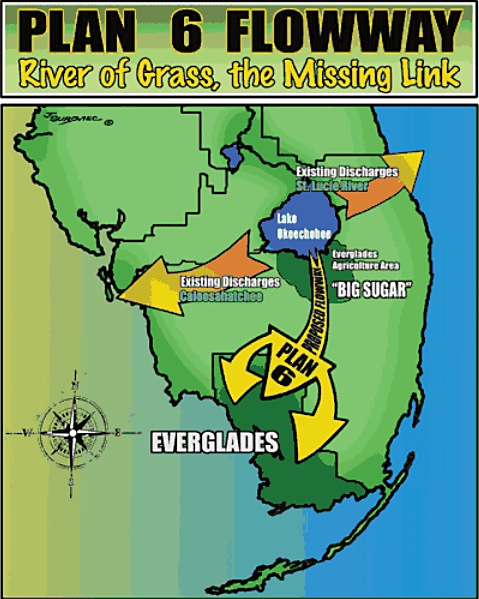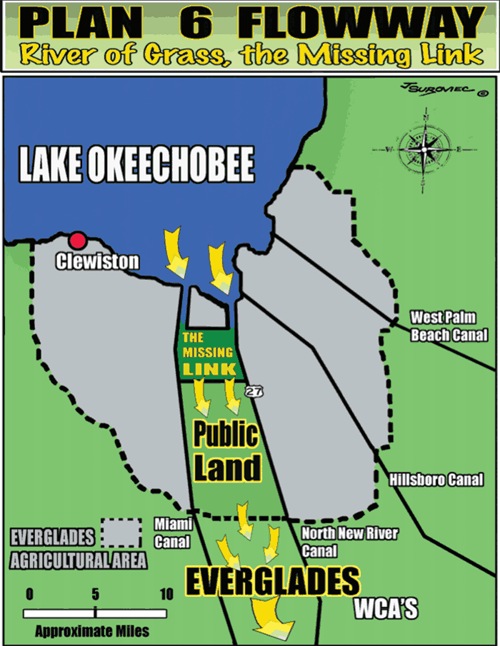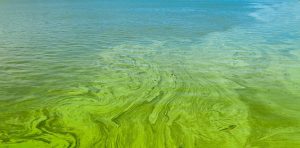
Overview of an expansive Plan Six Missing Link Flowway that incorporates the flowway as first described by the U.S. Army Corps of Engineers, the acquisition of limited agricultural property and inclusion of some projects outlined in the Central Everglades Planning Project.
– Rivers Coalition Defense Fund, 2013
What is Plan Six?
Facing sieges of disastrous discharges from inland, the St. Lucie river estuary, as well as the Caloosahatchee river to the west, must gain emergency measures to stem the releases permanently.
This “New and Broader Plan 6 Flowway” program would simply create a vitally needed flowpath to let water move south from Lake Okeechobee to the Everglades instead of to the coastal estuaries.
A broadened approach includes acquisition of about 50,000 acres of the 700,000 acres in the Everglades Agricultural Area (7%). The new acreage would be tied into lands already in public hands to form the overall Plan 6 flowway.
What About Other Plans?
The new Plan 6 program also would embrace the most helpful features in the Central Everglades Planning Project (CEPP), recognizing, however, that the CEPP changes by themselves will reduce discharges by no more than 14%. A much greater reduction is necessary if estuary life and benefits are to be brought back.
The Rivers Coalition Defense Fund concludes that the broader Plan 6 Missing Link Flowway would be simpler, faster and less expensive than alternatives.
It should be emphasized that two-thirds of the Plan 6 path is already in public hands.
The remaining one-third is potentially available under a state option to purchase lands from the U.S. Sugar Corp. or other sources.
Although present state officials have not pursued the sugar purchase, it had been strongly supported by the previous state administration and South Florida Water Management District. Funding was found to be practical via restructured bonding. Potential benefits were judged to be far greater than costs.
The Water Management District’s website includes this 2008 statement regarding the purchase.
“Acquiring the enormous expanse of real estate offers water managers the opportunity and flexibility to store and clean water on a scale never before contemplated to protect Florida’s coastal estuaries and to better revive, restore and preserve the fabled River of Grass.”
A majority of other public and non-government entities also supported the purchase, which drew international favorable attention. Political changes and the economic recession, however, led to setting aside the Missing Link purchase, while preserving an option to buy that extends to 2020.
The Defense Fund finds that the option, or similar acquisition, must be implemented in order to provide a meaningful solution to the estuary and Everglades drainage woes that beset us. It is now up to the Water Management District, coordinating with other state officials, to execute the purchase and flowway.
Continuing damages to our eco-system, to our quality of life and to our economy are far too severe to accept do-little measures or distractions that only preserve the destructive status quo.
Who Opposes Plan Six?
Resistance to the flowway comes basically from industry lobbyists and allied political forces, who make two main claims.
One is that a series of aquifer storage and recovery (ASR) wells proposed for locations around Lake Okeechobee could drain, store and supply water, negating the need for the flowpath south.
The deep-well technology is highly controversial, however. Many scientists contend that the wells would handle only a tiny fraction of the water involved and that they would be subject to dangerous exposures of pollution such as arsenic.
Moreover, the wells would preclude vitally needed re-hydration and re-creation of historic wetlands.
Costs estimates for ASR run to $1.8 billion, whereas Plan 6 outlays are estimated to be less than half of that.
The state of Georgia has banned ASR injections into the same Floridan Aquifer present in Florida. A wealth of information about ASR is readily available via web search engines.
What About the Bowl Effect?
A second claim against the flowway concept is that the natural downward slope through the agricultural area has been disrupted by loss of soil, causing a supposed blockage of potential flow.
This claim is still voiced by some key officials, although it has been thoroughly discredited for many years. A careful analysis of the topography involved shows that the Plan 6 flow would work well. An evaluation of the bowl claim may be seen at RiversCoalition.org
Will Plan Six Really Stop the Nasty Water?
Plan 6 can do more than any other program to curtail the discharges and restore wetlands. It was originated by the Corps itself and is supported by a host of veteran engineers and conservationists.
The public must demand real action for a new and broader Plan 6 Flowway, as well as support any other potential remedies.
For more information see the Plan 6 Concept report at RiversCoalition.org, the Florida Oceanographic Society and other sources.
So How Do We Make All This Happen? Who Makes the Decisions?
It is up to both state and federal authorities to move the ball. Your insistence and support can make it happen.
The contracting party for purchasing the Missing Link land is the South Florida Water Management District, headquartered in West Palm Beach. It operates as an arm of the Florida Legislature. The District’s Board of Governors is appointed by the governor.
The state SFWMD works in partnership with federal entities, notably the U.S. Army Corps of Engineers and Department of Interior, which in turn operate under the U.S. Congress.
Yes, it’s complex and there are numerous players. In the end, all of us must demand the flowway and drainage reforms.
10 Key Points About the Plan Six Flowway - River of Grass, the Missing Link
• Stops polluted discharges from Lake O to estuaries
• Needs just 15% of “Big Sugar” fields
• Simpler and cheaper than current plans
• Brings back estuary wildlife and plant life
• Restores crucial natural sheetflow to Everglades
• Stops pathogens dangerous to humans and others
• Reduces risk of Lake O Hoover dike failure
• Curtails tons of muck that degrade waters
• Restores wetlands lost to overdrainage
• Helps recharge Biscayne Aquifer and cuts waste to ocean


